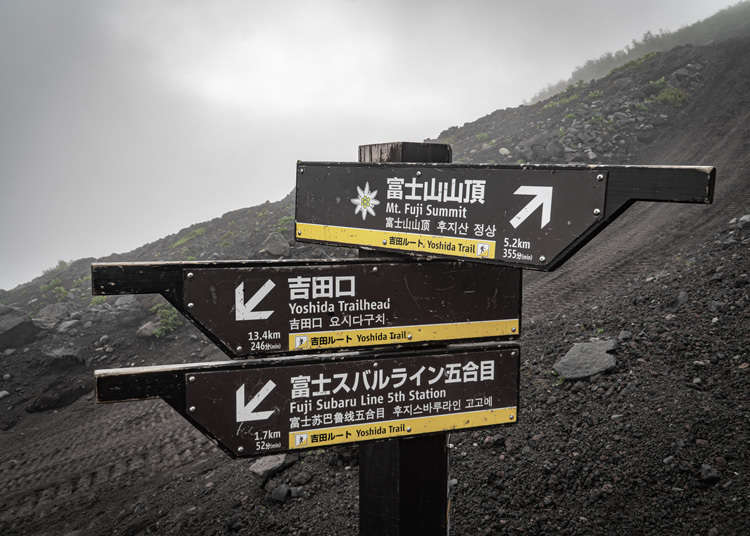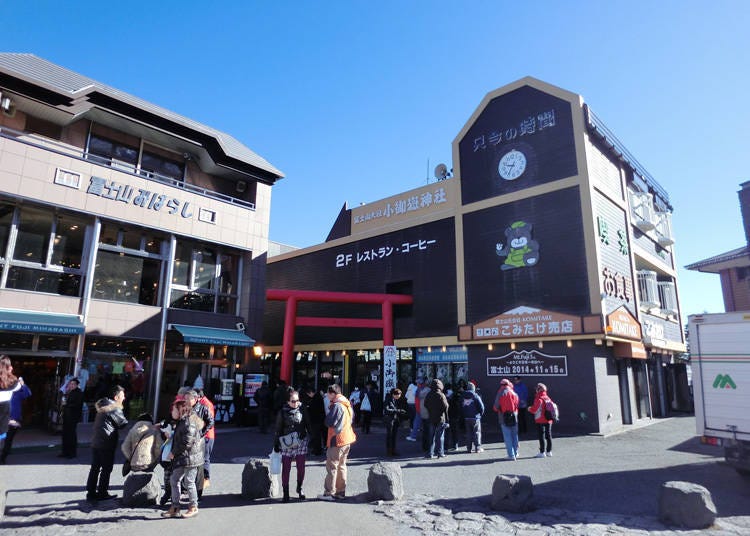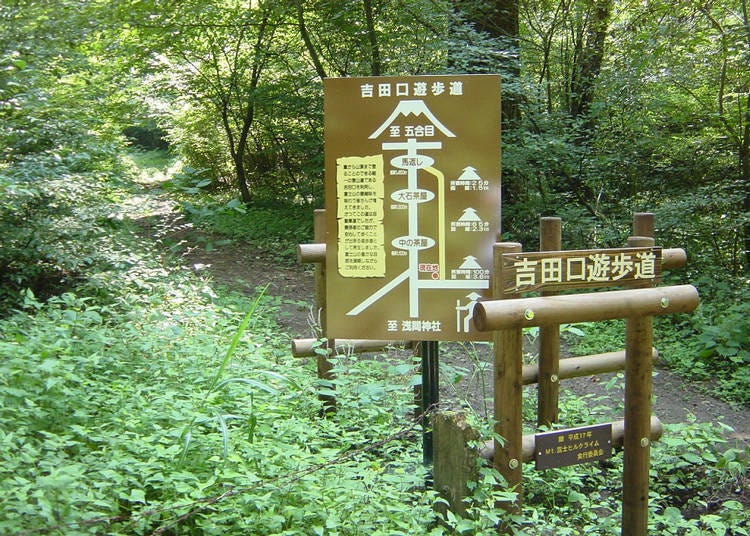
Of Mt. Fuji’s climbing routes, the Yoshida Trail is used by the largest number of climbers. It’s a varied path that features both flat and zigzagging sections. Here are the basics of the Yoshida Trail, including its features and facility information.
Features of the Yoshida Trail

Located on the Yamanashi side, the Yoshida Trail leads to the summit on the Mt. Fuji’s north side and is used by more than half of those who climb the mountain. Starting from the Fuji Subaru Line Fifth Station, the trail converges with the Yoshidaguchi Trail at the Sixth Station.
Fifth Station altitude: 2305m
Round trip distance: about 14km (ascent 6.8km; descent unspecified)
Approximate climbing time: about 6 hours to ascend; about 4 hours to descend
One notable difference between the ascending and descending portions of the trail is the number of mountains huts. The ascent has plenty for climbers to rest, but there are almost none on the way down.
Yoshida Trail Notes

Starting from the Fifth Station of the Fuji Subaru Line, the trail is flat and wide before coming to the first fork at Izumigataki. From there climbers can continue the ascent or head to Yoshidaguchi Fifth Station.
The journey to the Sixth Station is steep and passes through the tree line. As you approach the station you’ll see the Mt. Fuji Safety Guidance Center and from there the Yoshida Trail joins the Yoshidaguchi Trail that starts below, at Kitaguchi-hongu Fuji Sengen Shrine. On this section of the trail, be careful of heat stroke because there isn’t much shade.
Since the route from the Sixth Station is steep, mountain climbing equipment will be required. The trail zigzags on for a while and then you’ll come to the Seventh Station and the first mountain hut, “Hanakoya.” After the hut, there are numerous steep, rocky points. Depending on the season, the number of night climbers attempting to reach the summit in time to see the sunrise may be high, congesting the trail.
As the altitude exceeds 3000m at the Eighth Station, the number of people who experience altitude sickness will increase. The Yoshida Trail merges with the Subashiri Trail at the Original Eighth Station.
The Yoshida Trail descent follows a different path than the one that leads up Mt. Fuji and from the summit down to the Eighth Station (Shita Edoya) it again shares the same course as the Subashiri route.
Be careful not to miss the yellow signs marking the Yoshida Trail, which is often confused with the Subashiri Trail at the junction near Shita Edoya. If you take a wrong turn and end up on the Subashiri Trail, you’ll have to complete the trip down the mountain by bus from the Subashiriguchi Fifth Station.
From the Seventh Station, the trail leads down to the Sixth Station and then on to the Fifth Station of the Fuji Subaru Line.
Main Facilities on the Yoshida Trail
There are many mountain huts as you climb upward, but there are no mountain huts on the descending side after the Shita Edoya Eighth Station. Also, there are no toilets on the descent until the Seventh Station, so making use of the facilities at the summit is recommended.
Facilities at the Yoshida Trail Sixth Station
・Mt. Fuji Safety Guidance Center
Open 24 hours.
・Public toilets
Facilities between the Yoshida Trail Sixth and Seventh Stations
・Seventh Station First Aid Station
A doctor is on duty 24 hours.
・Mountain huts
There are seven mountain huts at the Seventh Station: Hanakoya, Hinodekan, Nanagome Tomoekan, Kamaiwakan, Fuji Ichikan, Toriiso, and Toyokan.
Vacancy is limited, so reservations are recommended.
Facilities located between the Yoshida Trail Seventh and Original Eighth Stations
・Eighth Station First Aid Station
A doctor is on duty 24 hours.
・Mountain huts
There are seven mountain huts between the Eighth Station and the Original Eighth Station: Taishikan, Horaikan, Hakuunso, Gansomuro, Fujisan Hotel, Honhachigome Tomoekan, and Goraikokan.
Also take note that the Yoshida Trail is often crowded. And remember, since there are few facilities on the descending trail, be careful to rest at the summit and take advantage of the toilets located there.
-

-
Address
Fujiyoshida-shi, Yamanashi, 403-0000
View Map -
Nearest Station
Gotemba Station (JR Gotemba Line)
-
Address
Fujiyoshida-shi, Yamanashi, 403-0000
- Area
- Category
*Prices and options mentioned are subject to change.
*Unless stated otherwise, all prices include tax.
Popular Tours & Activitiess
-

Strawberries, Style, and Tokyo’s Coolest Neighborhood: Winter Afternoon Tea in Kichijoji
by: Guest Contributor
-

First Japan Cherry Blossom 2026 Forecast Announced! Here's When & Where to See Sakura in Japan
-
Ad

Discover the "Miraculous Forest" in the Heart of Tokyo: The Institute for Nature Study (9 Minutes from JR Meguro Station)
-
Ad

(Opening in Jan 2026) 'THE SUMO LIVE RESTAURANT HIRAKUZA GINZA TOKYO!' 5 Exciting Ways to Experience the World of Sumo!
-

Jujutsu Kaisen Takes Over JR East With a Wrapped Shinkansen This Winter
by: Guest Contributor
-
Ad

Preserving the Beauty of World Heritage Site Shirakawa-go for the Future Through Responsible Travel
Inspiration for Accommodations
-

Enjoy Mt. Fuji from the Comfort of Your Room! Recommended Ryokan with Mt. Fuji View
-

Stay Near the Cherry Blossoms! Hotels for Cherry Blossom Viewing in Tokyo
-

Family-Friendly Hotels with Free Shuttle to Disneyland: Convenient Access for a Magical Stay
-

Top Ranked Hakone Hotels with Mt. Fuji View: Enjoy Stunning Scenery from Your Private Space
-

Convenient Tokyo Hotels with Airport Shuttle: Ideal for Families and Heavy Luggage
-

Stunning Tokyo Tower View Hotels: Enjoy Spectacular Scenery from Your Private Space
-

Convenient Asakusa Hotels with Kitchens: Ideal for Extended Family Visits
-

Experience Luxury: Hakone's 10 Best Five-Star Accommodations
-

Enjoy Mt. Fuji Autumn Leaves! Top Hotels Near the Popular Autumn Leaves Corridor
-

Experience Hakone Fall Foliage from Your Room with Stunning Views
-

Bicycling Tour of Tokyo: 3 Sightseeing Cycle Guides for Seeing Tokyo this Spring!
by: David McElhinney
-

Discover Asakusa Through the Eyes of a Taiwanese Rickshaw Puller - Top Attractions & Sweet Treats Revealed!
-

Tokyo Tsukiji|Tsukiji Area Map & Sightseeing Information
-

10 Tokyo Places You Can Enjoy for Free!
-

Recharge your batteries with a relaxing, lake-themed break in Nagano
-

Kichijoji – Explore Tokyo’s Top-Rated Stylish Suburb in Half a Day!
- #best ramen tokyo
- #what to buy in ameyoko
- #what to bring to japan
- #new years in tokyo
- #best izakaya shinjuku
- #things to do tokyo
- #japanese nail trends
- #what to do in odaiba
- #onsen tattoo friendly tokyo
- #daiso
- #best sushi ginza
- #japanese convenience store snacks
- #best yakiniku shibuya
- #japanese fashion culture
- #best japanese soft drinks



















